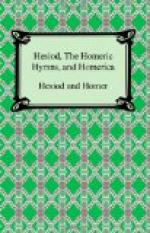Before we go on to the story of Hesiod’s death,
it will be well to inquire how far the “autobiographical”
notices can be treated as historical, especially as
many critics treat some, or all of them, as spurious.
In the first place attempts have been made to show
that “Hesiod” is a significant name and
therefore fictitious: it is only necessary to
mention Goettling’s derivation from IEMI to
ODOS (which would make `Hesiod’ mean the `guide’
in virtues and technical arts), and to refer to the
pitiful attempts in the “Etymologicum Magnum”
(s.v.
Again, Hesiod’s story of his relations with his brother Perses have been treated with scepticism (see Murray, “Anc. Gk. Literature”, pp. 53-54): Perses, it is urged, is clearly a mere dummy, set up to be the target for the poet’s exhortations. On such a matter precise evidence is naturally not forthcoming; but all probability is against the sceptical view. For 1) if the quarrel between the brothers were a fiction, we should expect it to be detailed at length and not noticed allusively and rather obscurely — as we find it; 2) as mm. Croiset remark, if the poet needed a lay-figure the ordinary practice was to introduce some mythological person — as, in fact, is done in the “Precepts of Chiron”. In a word, there is no more solid ground for treating Perses and his quarrel with Hesiod as fictitious than there would be for treating Cyrnus, the friend of Theognis, as mythical.
Thirdly, there is the passage in the “Theogony” relating to Hesiod and the Muses. It is surely an error to suppose that lines 22-35 all refer to Hesiod: rather, the author of the “Theogony” tells the story of his own inspiration by the same Muses who once taught Hesiod glorious song. The lines 22-3 are therefore a very early piece of tradition about Hesiod, and though the appearance of Muses must be treated as a graceful fiction, we find that a writer, later than the “Works and Days” by perhaps no more than three-quarters of a century, believed in the actuality of Hesiod and in his life as a farmer or shepherd.




